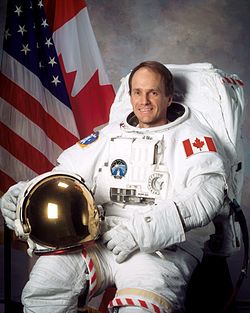Astronaut Steve MacLean talks with Canadian PM over phone
Friday, September 15, 2006

The Canadian PM Stephen Harper spoke with astronaut Steve MacLean over the phone yesterday from Ottawa. MacLean was on the STS-115 (space shuttle Atlantis). He is also the second Canadian to walk in space.
Harper congratulated MacLean and asked him questions, including one from Harper's son, Ben. The question was: "What time do the astronauts go to bed?" "On our mission, with where the sun is, we have 55 minutes of daylight followed by 75 minutes of darkness ... and that does affect your circadian rhythm," MacLean replied. The astronauts' sleep pattern "is driven by the rendezvous that we do with the station. That time is the key milestone and then we arrange our sleep schedules around that." "But you can tell your son that sleeping in space is wonderful. We all sleep down on the main deck, some of us right side up, some of us are on the side and some of us are upside down. There's more orientations up here, basically."
Harper told MacLean that the country is proud of his achievements. "I'm sure it's an adventure of a lifetime and ... I expect your mission will inspire millions of Canadians, young people, and even some who are talking to you today to become interested in space and science and technology," Harper said.
Harper wished MacLean well as the mission winds down. "I know you said ... you wanted to bring home a gold medal for Canada, from everything I've seen on your performance yesterday, you are well on your way," Harper said.
Canadian school children also got a chance to ask MacLean about his time aboard the shuttle.
MacLean walked in space on Wednesday. MacLean, with fellow Atlantis crew member Dan Burbank started their six-hour spacewalk at the international space station at 5:05 am ET. They are focusing their attention and tools on a ferris-wheel-like rotary joint that will allow two solar arrays, once unfurled, to always face the sun as the space station circles Earth. The solar arrays will supply a quarter of the space lab's power when it is completed by 2010.
Sources
edit- Canadian Press. "MacLean chats with Harper, students after solar panels unfurled in orbit" — canada.com, September 15, 2006
- "PM calls MacLean onboard space shuttle" — Ottawa Citizen, September 15, 2006
- "Canada's Steve MacLean makes historic spacewalk" — CTV, September 13, 2006
| This page has been automatically archived by a robot, and is no longer publicly editable.
Got a correction? Add the template {{editprotected}} to the talk page along with your corrections, and it will be brought to the attention of the administrators. Please note that the listed sources may no longer be available online. |